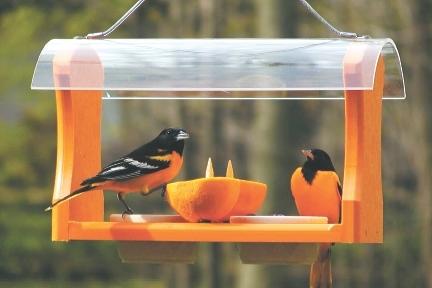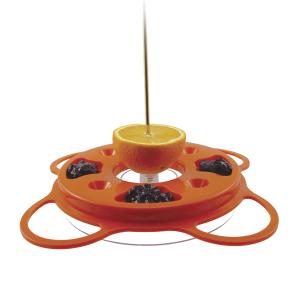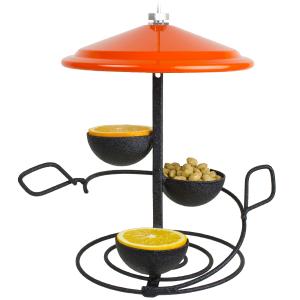Many of us dream of having an oriole take up residence in our yard or neighborhood. They arrive starting in mid-April. Hearing a brilliant-colored male serenade potential mates with its uplifting whistle is truly a cause for celebration! Out of nine possible U.S. species, the Orchard and Baltimore orioles are the ones we see in the eastern U.S.
Attracting Baltimore Orioles
Attracting Orioles To Your Yard - Watch the YouTube Video Here
Who's excited to see Orioles this year?! Since we had so many Baltimore Oriole sightings last year, we are getting excited about attracting our beautiful orange migrants again! In this video, store manager Connor Fox provides some quick tips about how to attract these sought-after birds to your yard.

Feeding
Orioles can be drawn to your yard if you provide food such as orange slices or halves, grape jelly, mealworms and/or nectar. Homemade nectar should be a mix of 6 parts water to 1 part sugar; so 2 cups water with 1/3 cup of sugar, for example. Since orioles fly high up in the trees, you need to place their feeder in an open area so they will see it from the air. It is also a good idea to put their feeders in an area away from your other bird feeders. Freshen up the food every few days and keep the feeder clean and you have a better chance of having them stay around once they have found you.
If your dream is to have one of these brilliant and artistic birds as a resident in your yard, our Certified Bird Feeding Specialists can show you the oriole nectar, mealworm and fruit feeders that might just make your dream become reality.
Nesting
Orioles nest high up in the tree canopy. The oriole nest is an engineering masterpiece and is one of the most amazing and complicated nests of any North American bird.
Looking like a small gourd-shaped pouch hanging from the tip of a thin branch, oriole nests are skillfully woven out of hundreds of single fibers … one at a time. Building materials include plant fibers, grasses, vines, tree bark. It can take as many as 15 days for an Oriole to weave its nest. One Baltimore Oriole was observed spending 40 hours building a nest with about 10,000 stitches and the tying of thousands of knots, all with its beak.
The female oriole is the primary engineer and fabricator, but males occasionally plays the role of foreman, supplying materials and conducting inspections while the nest is under construction.
While nests are typically woven out of plant fibers such as strips of milkweed stem, man-made items, such as string and yarn, are readily used in their place. Horses also provide nesting materials in the form of hair from their tail and mane. You can help them by placing 6" pieces of natural string or yarn on tree limbs or in suet cages.
Migration
- January: Baltimore orioles begin the new year in the tropics, mostly in social flocks that look like bright tropical ornaments in good feeding trees.
- February: Baltimore orioles are on their wintering grounds in Florida, Central America, and the northern part of South America, with a handful usually in coastal California and occasionally a straggler or two survive the winter in the central or even northern states. Some are starting to migrate through Panama all through the month.
- March: Some migrating Baltimore orioles are reaching Mexico, while many are still found south to Panama.
- April: The peak of oriole migration occurs from mid-April through mid-May. The first Baltimore orioles are reaching Texas, and by month's end, a few are reaching the central states.
- May: Baltimore orioles reach the northern states and provinces. May is the peak month for nest-building.
- June: This is the month most baby Baltimore orioles hatch. Parents are busy incubating eggs and raising babies. Baby-rearing peaks this month.
- July: As Baltimore oriole babies become independent, parents begin molting their body and flight feathers, and some are already starting to migrate at the beginning of the month!
- August: Migration for Baltimore Orioles peaks in August and September. Birds are steadily molting their body and flight feathers.
- September: Migration for Baltimore Orioles continues. Birds are still molting their body and flight feathers.
- October: Migration for Baltimore Orioles in North America ebbs during the first half of the month, and most birds reach their tropical wintering grounds. Birds are done molting their body and flight feathers.
- November: Baltimore Orioles are mostly in the tropics, though a few individuals linger, even in the northern states and provinces. No one knows why some individuals are stragglers every year--most of these are seen in November and December, so ornithologists believe most of them end up dying as winter gets more severe.
- December: Just about all Baltimore orioles are in the tropics, but one or two stragglers might be seen on Christmas Bird Counts.
Fun Facts About Orioles
- When not feeding on nectar, orioles seek out caterpillars, fruits, insects, and spiders.
- Unlike many insect eating birds, Baltimore Orioles will eat spiny or hairy caterpillars, including such pest species as fall webworms, tent caterpillars, and gypsy moths.
- Most male Baltimore Oriole songs vary enough from one another as to be unique to each individual. It is believed females can identify and locate their mate by its distinct song.
- While modern day Oriole nests are made primarily of plant fibers, Oriole nests collected in the late 1800s, before the age of the automobile, were made almost exclusively of horsehair.
- Orioles will lay 4-5 eggs anywhere from April to June. The young will fledge as late as 30 days from egg laying.
- Orioles are found across North America in the summer. Some species winter in the tropics and others in Mexico.
- Most Baltimore Orioles spend their winters in southern Mexico, Central America and the tropics, but some will stay in the southern states of the U.S., with a few reports as far north as New England.
- The Baltimore Oriole is a common inhabitant of suburban landscapes due to is preference for open settings that are bordered with mature trees.
- Oriole’s are a member of Icteridae family, meaning that their closest bird relatives include meadowlarks, blackbirds, bobolinks and grackles.
- The oriole gets its name from the Latin aureolus, which means golden.
- The oldest banded Baltimore Oriole recaptured in the wild had lived 11 years and 7 months.




